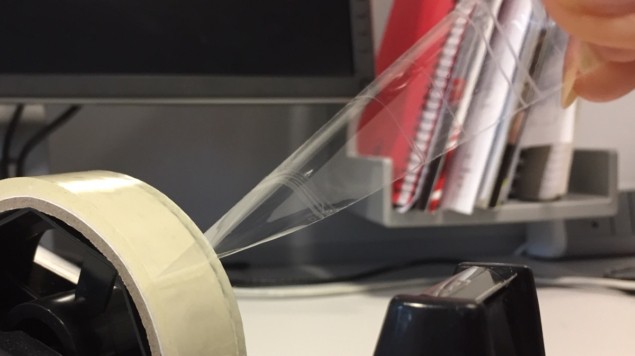
Researchers in France have made new discoveries about the way in which sticky tape peels away from surfaces. Stéphane Santucci and colleagues at the École Normale Supérieure in Lyon used observations from a high-speed camera to explore the complex physics involved in the peeling process on microscopic scales. Their observations have allowed them to identify strict mathematical relationships underlying the process, but questions still remain over the causes of some of its observed properties.
Peeling tape away from a surface is a familiar, yet often frustrating experience; while it remains firmly stuck to the surface at some points, it can peel away too quickly at others. The physics underlying this behaviour has been poorly understood until recently, but studies in 2010 uncovered a characteristic pattern in which peeling repeatedly stops and starts on scales of millimetres. Santucci and colleagues explored the scenario in further detail in 2015, revealing that this macroscopic stick–slip behaviour arises from energy being released close to the front separating the stuck and peeled tape.
Now, Santucci’s team have studied the process in unprecedented detail using a high-speed camera mounted to a microscope, together with an electric motor that precisely controls the velocity and angle of the peel. Their measurements revealed that when tape is stuck for longer periods of time, the subsequent slip would cover larger distances, with the two quantities following a strict cube-root relationship. Slip distances also increased linearly with the peeling angle and the stiffness of the tape.
Santucci and colleagues propose that the behaviour arises because both the tape’s adhesive, and the point at which it bends, build up elastic potential energy during sticking. Over the course of a slip, this potential is subsequently released at the tape’s separation front in the form of kinetic energy. From these insights, the researchers constructed a theoretical model incorporating the cube-root relationship underlying this energy budget. Their simulations accurately predicted the peeling behaviours of tapes with a variety of properties.
Intriguingly, the team’s models were able to recreate the waves that propagate across the separation front, perpendicular to the tape, at speeds of up to 900 m/s during a slip. The cause of this behaviour has yet to be explained, but the researchers compare it with the developments of cracks in solid materials – since in both scenarios new surfaces are created along propagating lines. In future work, Santucci’s team hope to use their simulations to learn more about this mysterious behaviour.
Full details are reported in Physical Review Letters.



